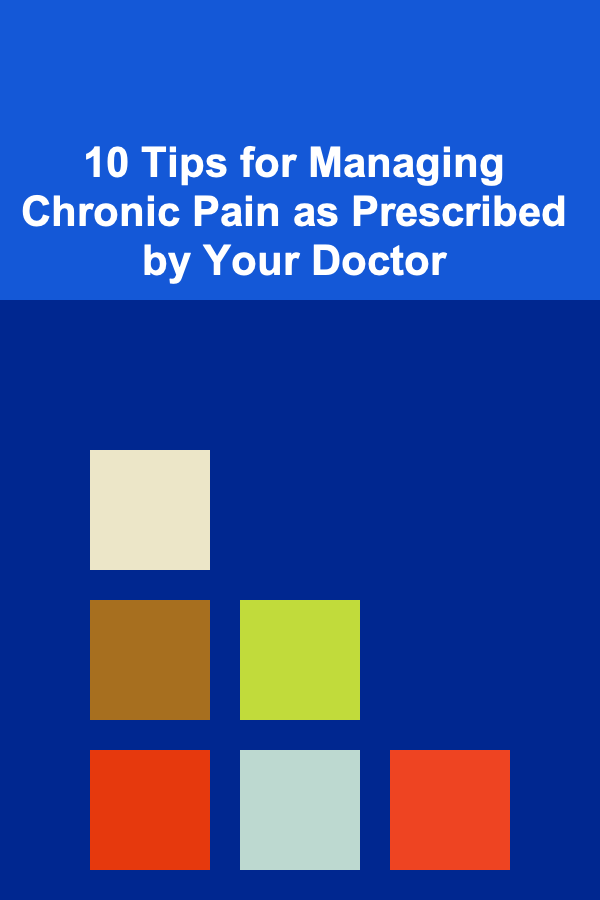
10 Tips for Managing Chronic Pain as Prescribed by Your Doctor
ebook include PDF & Audio bundle (Micro Guide)
$12.99$7.99
Limited Time Offer! Order within the next:

Chronic pain affects millions of people worldwide, impacting every aspect of daily life. For those dealing with chronic pain, it can feel overwhelming to manage, especially when traditional treatments don't always provide lasting relief. While medications and treatments prescribed by a doctor are crucial to pain management, adopting a holistic approach can enhance the effectiveness of these interventions and improve quality of life.
This article provides 10 valuable tips for managing chronic pain as prescribed by your doctor, focusing on lifestyle adjustments, exercise, mental health support, and other complementary strategies. These tips can help you navigate the complexities of chronic pain while taking an active role in your treatment.
Follow Your Doctor's Prescriptions Carefully
The foundation of managing chronic pain begins with adhering to your doctor's prescribed treatment plan. Whether it involves medications, physical therapy, or other interventions, following your doctor's instructions is vital for effective pain management. It may be tempting to adjust the dosage or skip doses, especially if you feel better or are experiencing side effects, but doing so can undermine the effectiveness of your treatment.
Why It's Important:
- Dosage and Timing: Medications, including pain relievers, anti-inflammatory drugs, or muscle relaxants, work best when taken at the correct times and in the right doses. Skipping doses or taking them at irregular intervals can lead to an inconsistent therapeutic effect and potentially increase the risk of side effects.
- Consistency: Chronic pain management often requires a long-term commitment to treatment. Sticking to your prescribed regimen ensures that the treatment remains effective over time and reduces flare-ups of pain.
If you have concerns about side effects or effectiveness, don't hesitate to communicate with your healthcare provider. They may adjust your treatment to better suit your needs.
Implement Regular Exercise
While it may seem counterintuitive to engage in physical activity when you're in pain, regular exercise is one of the most effective strategies for managing chronic pain. Exercise helps strengthen muscles, improve joint flexibility, and reduce inflammation, all of which contribute to reducing pain levels.
Types of Exercise for Chronic Pain:
- Low-Impact Activities: Opt for low-impact exercises like swimming, walking, or cycling. These activities are easier on the joints and provide significant benefits without exacerbating pain.
- Stretching and Yoga: Gentle stretches or yoga poses can improve flexibility and reduce muscle stiffness. Yoga, in particular, can also enhance mental relaxation, which is crucial in managing pain.
- Strength Training: Building strength in key areas, such as the back, core, and legs, can help alleviate stress on the body and reduce pain. Work with a physical therapist to ensure exercises are done correctly.
Before starting any new exercise program, consult your doctor to ensure it's safe for your specific condition and level of pain. The goal is to find an activity routine that helps manage pain without aggravating it.
Maintain a Healthy Diet
Your diet plays a significant role in managing chronic pain. Certain foods have anti-inflammatory properties that can reduce pain and swelling, while others can exacerbate inflammation and increase discomfort. A balanced, nutrient-rich diet can enhance the body's natural ability to heal and better manage chronic pain.
Anti-Inflammatory Foods:
- Omega-3 Fatty Acids: Found in fatty fish like salmon and mackerel, as well as flaxseeds and walnuts, omega-3s are known for their ability to reduce inflammation.
- Fruits and Vegetables: Rich in antioxidants, vitamins, and minerals, fruits and vegetables, particularly leafy greens, berries, and cruciferous vegetables, can support overall health and combat inflammation.
- Turmeric and Ginger: Both turmeric and ginger contain compounds with anti-inflammatory properties that may help reduce pain.
Foods to Avoid:
- Processed Foods: Refined sugar, white bread, and processed snacks can increase inflammation and exacerbate pain.
- Trans Fats: Found in many fried and processed foods, trans fats can also contribute to inflammation.
A healthy diet not only helps with pain management but also supports overall well-being. Consult with a nutritionist or your doctor to create a diet plan tailored to your needs and pain management goals.
Prioritize Rest and Sleep
Chronic pain can disrupt sleep, and lack of sleep can, in turn, make pain worse. It's crucial to prioritize rest and sleep, as proper sleep is a cornerstone of managing chronic pain effectively.
How to Improve Sleep Quality:
- Create a Restful Environment: Make your bedroom a sanctuary for sleep. Keep the room dark, quiet, and cool. Use a comfortable mattress and pillows to reduce pressure on painful areas.
- Establish a Routine: Going to bed and waking up at the same time each day helps regulate your body's internal clock, improving the quality of your sleep.
- Limit Stimulants: Avoid caffeine, alcohol, and heavy meals before bedtime, as they can interfere with your ability to fall and stay asleep.
If sleep continues to be problematic, speak with your doctor. They may recommend a sleep study or suggest treatments such as cognitive behavioral therapy for insomnia (CBT-I) to improve your sleep patterns.
Engage in Mindfulness and Stress-Reduction Techniques
Chronic pain often leads to increased levels of stress and anxiety, which can exacerbate the pain experience. Managing stress through mindfulness and relaxation techniques can significantly reduce pain perception and improve your emotional well-being.
Mindfulness and Relaxation Practices:
- Meditation: Regular meditation can reduce stress and improve your ability to cope with pain. Mindfulness meditation, in particular, encourages you to focus on the present moment, which can lessen the emotional response to pain.
- Deep Breathing Exercises: Breathing techniques, such as diaphragmatic breathing, can activate the parasympathetic nervous system, helping the body to relax and reduce tension.
- Progressive Muscle Relaxation (PMR): This technique involves tensing and relaxing different muscle groups in the body, promoting relaxation and reducing muscle tension associated with pain.
If you're new to mindfulness or relaxation techniques, start slowly. Consider joining a class or working with a therapist to learn effective methods for managing stress and pain.
Use Heat and Cold Therapy
Heat and cold therapy are common, doctor-prescribed methods for managing chronic pain. Both therapies can help alleviate pain, reduce inflammation, and improve mobility, but it's essential to know when and how to use them.
Heat Therapy:
- Heat increases blood flow to an area, which helps relax muscles and soothe stiff joints. This therapy is particularly useful for muscle pain or chronic back pain.
- Use heating pads, warm baths, or hot packs to apply heat to the affected area. Limit application to 20 minutes at a time to avoid skin damage.
Cold Therapy:
- Cold therapy can reduce inflammation and numb painful areas. It is often used for acute pain, swelling, or inflammation but can also be useful for chronic conditions like arthritis.
- Ice packs, cold compresses, or ice baths can be used for cold therapy. Apply cold for 15-20 minutes at a time, and never apply ice directly to the skin to avoid frostbite.
Your doctor can advise you on which therapy is best for your particular condition and how to incorporate it into your routine.
Consider Cognitive Behavioral Therapy (CBT)
Cognitive Behavioral Therapy (CBT) is a well-established psychological treatment that can be highly effective in managing chronic pain. CBT helps individuals reframe negative thought patterns, develop healthier coping mechanisms, and improve emotional responses to pain.
How CBT Works:
- Identifying Pain Triggers: CBT helps you recognize how certain thoughts and emotions trigger or intensify pain, allowing you to modify those reactions.
- Changing Thought Patterns: It encourages positive thinking and coping strategies, such as focusing on activities that bring joy or practicing relaxation techniques.
- Building Coping Skills: CBT equips individuals with tools to manage pain more effectively, both mentally and physically.
Many people with chronic pain find that CBT provides relief not just from pain, but also from the emotional distress that often accompanies it. Speak with your doctor about referrals to a qualified therapist who specializes in CBT for pain management.
Stay Socially Engaged
Isolation can exacerbate feelings of pain and discomfort, both physically and emotionally. Engaging in social activities can provide a sense of connection, help distract from pain, and reduce feelings of loneliness and depression.
Tips for Staying Social:
- Join Support Groups: Online or in-person support groups for chronic pain can provide a sense of community and understanding.
- Stay in Touch with Friends and Family: Even if it's just a phone call or a short visit, staying connected with loved ones can have a positive impact on your mental health.
- Pursue Hobbies: Engaging in activities you enjoy, such as painting, gardening, or reading, can provide a welcome distraction from pain and foster positive emotions.
If chronic pain is affecting your ability to stay socially active, talk to your doctor about possible strategies to manage the pain while engaging in activities you love.
Consider Alternative Therapies
In addition to conventional treatments prescribed by your doctor, some people find relief through alternative therapies. While the effectiveness of these therapies varies from person to person, they can complement your primary treatment plan.
Popular Alternative Therapies for Chronic Pain:
- Acupuncture: This traditional Chinese medicine technique involves inserting thin needles into specific points on the body to alleviate pain and improve energy flow.
- Massage Therapy: Therapeutic massage can help relieve muscle tension, improve circulation, and reduce pain.
- Chiropractic Care: Chiropractors use manual manipulation to adjust the spine and joints, which can help reduce pain in certain conditions like lower back pain.
Always consult your doctor before pursuing alternative therapies to ensure they're safe and appropriate for your condition.
Keep an Open Line of Communication with Your Doctor
Effective chronic pain management requires ongoing communication with your healthcare provider. Keep your doctor informed about your pain levels, treatment progress, and any changes you experience. This open dialogue ensures that your treatment plan is continuously optimized to meet your needs.
Tips for Communicating with Your Doctor:
- Keep a Pain Journal: Track your pain levels, triggers, and responses to treatments. This data can help your doctor adjust your plan more effectively.
- Be Honest About Side Effects: If medications or treatments are causing side effects, let your doctor know so they can make adjustments.
- Ask Questions: Don't hesitate to ask your doctor about new treatment options, side effects, or any concerns you may have. Your doctor's guidance is key to managing your pain.
Managing chronic pain is a journey, and having a supportive healthcare team by your side makes all the difference.
Managing chronic pain requires more than just following prescriptions---it's about taking a holistic approach that incorporates lifestyle changes, emotional well-being, and open communication with your healthcare provider. By applying these 10 tips, you can improve your ability to manage pain effectively, improve your quality of life, and take control of your health.
Reading More From Our Other Websites
- [Personal Care Tips 101] How to Use Journaling for Better Personal Care and Mental Health
- [Trail Running Tip 101] Trail Running 101: Essential Tips for Beginners to Hit the Path with Confidence
- [Home Lighting 101] How to Use Lighting to Create a Romantic Atmosphere
- [Home Space Saving 101] How to Maximize Storage in Small Bedrooms with Space-Saving Solutions
- [Beachcombing Tip 101] Essential Gear and Tips for Your First Beachcombing Adventure
- [Star Gazing Tip 101] From Orion to the Milky Way: Mythical Stories Behind the Night Sky's Brightest Constellations
- [Personal Investment 101] How to Understand the Value of Fee-Only Financial Advisors Beyond Just Picking Investments
- [Personal Investment 101] The Best Ways to Monetize Your Deep Learning Skills
- [Tie-Dyeing Tip 101] Tie-Dye Trending: Modern Designs That Turn a Simple Pillowcase into a Statement Piece
- [Home Lighting 101] How to Use Lighting to Highlight Your Home's Architectural Features

Exploring Affordable Alternative Transportation Options for Commuters
Read More
How to Build a Checklist for Lawn Care and Maintenance
Read More
How to Cut Down on Dining Out and Save Money
Read More
How to Organize Your Online Calendar for Class Deadlines
Read More
How to Use Automation to Simplify Your Investment Strategy
Read More
How to Celebrate Successes as a Remote Team
Read MoreOther Products

Exploring Affordable Alternative Transportation Options for Commuters
Read More
How to Build a Checklist for Lawn Care and Maintenance
Read More
How to Cut Down on Dining Out and Save Money
Read More
How to Organize Your Online Calendar for Class Deadlines
Read More
How to Use Automation to Simplify Your Investment Strategy
Read More